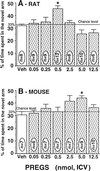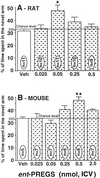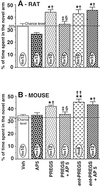The synthetic enantiomer of pregnenolone sulfate is very active on memory in rats and mice, even more so than its physiological neurosteroid counterpart: distinct mechanisms?
- PMID: 11717462
- PMCID: PMC61162
- DOI: 10.1073/pnas.241503698
The synthetic enantiomer of pregnenolone sulfate is very active on memory in rats and mice, even more so than its physiological neurosteroid counterpart: distinct mechanisms?
Abstract
The demonstration that the neurosteroid pregnenolone sulfate (PREGS) is active on memory function at both the physiological and pharmacological levels led to us examining in detail the effects of the steroid on spatial working memory by using a two-trial recognition task in a Y-maze, a paradigm based on the natural drive in rodents to explore a novel environment. Dose-response studies in young male adult Sprague-Dawley rats and Swiss mice, after the postacquisition intracerebroventricular injection of steroid, showed an U-inverted curve for memory performance and indicated a greater responsiveness in rats compared with mice. Remarkably, the synthetic (-) enantiomer of PREGS not only also displayed promnesiant activity, but its potency was 10 times higher than that of the natural steroid. Intracerebroventricular coadministration experiments with DL-2-amino-5-phosphonovaleric acid, a competitive selective antagonist of the N-methyl-D-aspartate receptor, abolished the memory-enhancing effect of PREGS, but not that of the PREGS enantiomer, evoking enantiomeric selectivity at the N-methyl-d-aspartate receptor and/or different mechanisms for the promnestic function of the two enantiomers.
Figures



References
Publication types
MeSH terms
Substances
Grants and funding
LinkOut - more resources
Full Text Sources
Other Literature Sources

